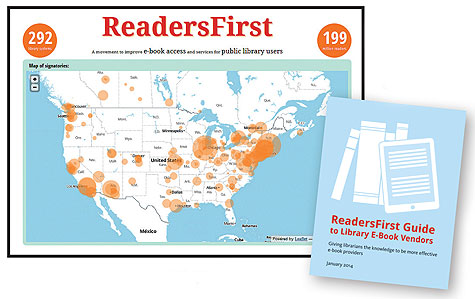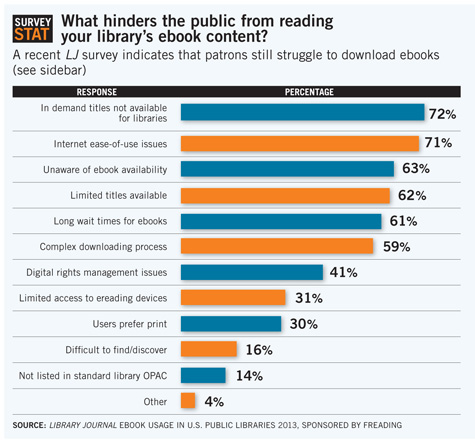Finding and downloading ebooks from libraries can still be “complicated and cumbersome, involving many steps that do not always work,” but several key vendors have taken steps to streamline and simplify ebook access in recent months, according to the long-anticipated “ReadersFirst Guide to Library Ebook Vendors,” which was released in January. It can be downloaded at ow.ly/sSN8c.
The ReadersFirst coalition has grown significantly since it began as a joint statement drafted and circulated by the New York Public Library (NYPL) and cosigned by 70 major library systems in June 2012. The group now includes almost 300 public library systems representing nearly 200 million readers, primarily in North America. But the organization’s demands have remained the same. It continues to call on publishers and ebook vendors to offer content in a way that allows readers to:
- Search one comprehensive catalog to access all of a library’s offerings
- Place holds, check out and renew items, view availability, manage fines, and receive communications within the single source the library has determined will serve its users best (website, catalog, or other)
- Seamlessly enjoy a variety of e-content
- Download ebooks that are compatible with all reading devices
In a sign of how much progress many vendors have made since those principles were first announced, the three largest platforms for popular ebooks all received fairly high marks in this first scorecard assessment. Out of 100 possible points, OverDrive received an 85, the 3M Cloud Library received an 84, and Baker & Taylor’s (B&T) Axis 360 platform received an 80.

BY THE NUMBERS ReadersFirst now represents almost 300 libraries and 200 million readers
The efforts of these companies on the first two fronts were largely responsible for their relatively high scores. OverDrive, 3M, and Axis 360 have all released application programming interfaces (APIs) and worked with a variety of ILS vendors to make it possible to discover, access, and check out ebooks without navigating away from a library’s online public access catalog (OPAC). The lack of integration had been a long-standing complaint for many librarians. As electronic resources proliferated, libraries and their patrons were faced with a growing number of platforms and interfaces with which to discover and access content from different vendors. With ebooks in particular, libraries had been working hard to build awareness of their collections while coaching patrons through the process of signing up for a service and downloading content to a variety of devices. Forcing patrons to navigate away from the OPAC to a separate interface every time they wanted to check out an ebook complicated matters further, especially for library systems that subscribed to multiple ebook services.
On the same page
Now, ebook and OPAC integration is “on its way to being accomplished. I think vendors are in different places, but they’re not as far away from each other anymore,” says Michael Santangelo, current coordinator of ReadersFirst and electronic resources coordinator for BookOps, the technical services organization serving NYPL and the Brooklyn Public Library (and a 2011 LJ Mover & Shaker).
“Part of the frustration [within the field] was that we didn’t have the vocabulary to articulate what we wanted,” Santangelo says. “The ReadersFirst requirements were based on what people wanted; we just changed it into technical language.”
These vendors have been receptive to ReadersFirst, Santangelo says. This is perhaps unsurprising, since 3M, OverDrive, and Axis 360 already had integration or API development efforts under way when ReadersFirst released its initial statement in 2012. Notably, 3M had been working closely with Polaris for months and had demonstrated a prototype of its integration at the Public Library Association (PLA) conference in March 2012 in Philadelphia.
OverDrive’s APIs were announced in May, and its developer portal went live in August 2012. Still, ReadersFirst’s requests—articulated in a weighted, 37-point product evaluation form—helped bring a new level of clarity and specificity to what libraries wanted. For example, an ebook vendor and an ILS must be able to communicate information about a patron’s account in order to facilitate a checkout through the OPAC. The ReadersFirst evaluation form explains that libraries want this information to include:
- Current number of and details about holds/requests, including titles, queue position, and expiration dates
- Number of holds and checkouts remaining, including maximum and remaining holds and loans (if applicable)
- Any other patron data stored by the vendor, such as email address and notification preferences
- Estimated wait time for items on hold
Similarly, eight specific demands are listed for item-level metadata, and seven each are listed for circulation transactions, administrative reporting and support, and general terms and conditions, among other categories.
Meanwhile, the formation of the coalition lent weight to those demands and helped vendors prioritize specific development goals, Santangelo explains.
“When we presented it, some vendors were really happy,” he says. “It gave them direction for what people were wanting.”
In partnership with Polaris, 3M’s Cloud Library was the first to achieve a nonbeta public rollout of a fully integrated system at the Baltimore County Public Library in December 2012. Tom Mercer, Cloud Library marketing manager for 3M, described a few of the system’s merits, noting that different platforms and different vendors continue to offer different levels of integration.
“We really set the bar with Polaris to make sure that the back end could have all integrated stats and unified reporting; [it would] automatically import books so when libraries buy ebooks in our tool, they end up in the catalog,” he says. “We have partnerships with various MARC record companies using our APIs, so that libraries [can use] any type of MARC record they want…. APIs are not all the same.”

In January 2013, SirsiDynix announced that it was working to integrate 3M Cloud Library, Axis 360, and OverDrive collections with its eResource Central electronic resource management tool. By the end of 2013, OverDrive and Axis 360 were working with Polaris as well. OverDrive and Axis 360 are also collaborating with The Library Corporation (TLC), and OverDrive and 3M are both in development with Innovative Interfaces.
“All of the [major vendors] are working on it, and some of them have gone live,” says David Burleigh, OverDrive’s director of marketing. “It’s getting out there. Some libraries are also working directly with our APIs themselves, if they have their own system.”
Proprietary platforms
Although there are clear benefits to these integration efforts, library OPACs arguably offer a less-than-optimal ebook browsing experience compared with the proprietary apps offered by each major platform. Livia Bitner, vice president of technical services and product development for B&T, says that the company plans to continue to enhance the Axis 360 platform and app, even as it continues to support the integration demands of ReadersFirst.
“It’s important that ebooks are easily discoverable in the OPAC, because then you’ll get new readers who say, ‘Oh, they have ebooks!’ or [offer options to] a person who doesn’t care about physical or ebook format,” Bitner says. “But if I’m an ebook user, why do I want to search and see the noise of physical books when I can go to the platform and find what I’m looking for in the format that I’m looking for?”
Mercer agreed, noting that many 3M Cloud Library customers have found the company’s proprietary discovery station kiosks helpful in marketing their ebook collections.
“We believe that finding our content in any interface is great,” he says. “So we’re going to make our own interfaces, and we’re going to make really great APIs for those that want integration.”
ReadersFirst doesn’t discourage these continued developments, but Santangelo says that while proprietary platforms may have some advantages, integration is the only way to ensure that content from multiple vendors is discoverable in one place.
“ReadersFirst is not here to tell people what they shouldn’t do; it’s to tell people here’s what we would like to see,” he says. “If you want to do all three [platforms], why shouldn’t content from those all be discoverable together?”
The work ahead
While the three major popular ebook platforms scored high, ebook platforms primarily targeted at research, education, and academic markets fared substantially less well in this initial survey of public libraries. However, the survey notes that EBSCO and Ingram both plan to make APIs available to developers later this year, which should raise their scores considerably. It also notes that GVRL and ebrary both have more in common with traditional databases than circulating ebook collections, precluding those platforms from several points of comparison.
Santangelo also acknowledges that the ReadersFirst coalition has much more leverage with library vendors and small publishers than it has with corporations like Amazon. Amazon seems intent on continuing to publish ebooks in its proprietary AZW format, and given the popularity of the company’s line of Kindle devices, it may be a while before ReadersFirst accomplishes its goals of enabling patrons to “seamlessly enjoy a variety of e-content” and “download ebooks that are compatible with all reading devices.”
“That goes outside of our expertise, dealing with Amazon,” Santangelo says. However, a number of recent surveys, including an October 2013 Pew report, have indicated that tablet ownership is outpacing ownership of dedicated ereaders. Since tablets, including the iPad and Kindle Fire, can install and run ebook apps from third-party vendors, proprietary formats may eventually be a nonissue. Regardless, ReadersFirst will continue to monitor emerging developments and encourage vendors and publishers to work with common formats, such as EPUB.
For more on the current state of ebooks in public libraries, see Tough to Read.
“There’s always the possibility that some new proprietary format could enter the market and knock everything back,” Santangelo says.
For now, he adds that the organization has been pleased with the level of cooperation and support that it has received from the vendor community.
“Pushing forward standard APIs does away with a lot of the back and forth, which is inefficient. It should be simple…. Efficiency works on everyone’s behalf and cuts down on labor on both the vendor and the library side,” Santangelo says. “You are not alone. You aren’t the only one working to try to get vendor X to work with vendor Y. It should be a given that they all work together. Everyone benefits.”


